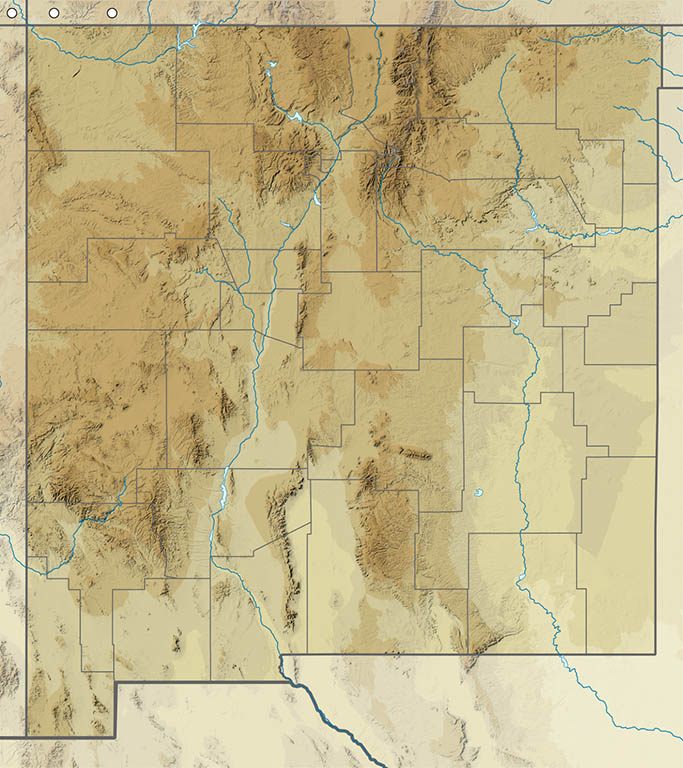by Steven J. Cary and Michael E. Toliver (updated March 15, 2022)
The Gossamerwings (Lycaenidae). New Mexico has more than 50 Lycaenids in three subfamilies: Coppers, Hairstreaks and Blues. All are small, but many have bright colors or intricate patterns. Because of narrow ecological needs, finding members of this group can be both challenging and rewarding. During immature stages, most Lycaenids exhibit mutualistic relationships with ants, called myrmecophily.
Coppers (Lycaenidae: Lycaeninae). Most coppers are brightly colored, at least on the top side. New Mexico has eight species, all restricted to the northern half of the state. They range from the widespread Purplish/Dorcas Copper complex to high alpine specialists such as the Lustrous Copper. Zhang et al. (Nov. 2020) demonstrated that most of our coppers belonged in the genus Tharsalea Scudder rather than Lycaena [Fabricius].
- Lustrous Copper (Lycaena cupreus snowi)
- Bronze Copper (Tharsalea hyllus)
- Blue Copper (Tharsalea heteronea gravenotata)
- Purplish Copper (Tharsalea helloides) florus,
- Dorcas Copper (Tharsalea dorcas sangremar)
- Ruddy Copper (Tharsalea rubidus sirius) Tharsalea rubidus ferrisi
- Gray Copper (Tharsalea dione)
- Tailed Copper (Tharsalea arota schellbachi)
- Lilac-bordered Copper (Tharsalea nivalis browni )
Lycaena cupreus (W. H. Edwards 1870) Lustrous Copper (updated March 13, 2022)
Description. Male Lustrous Coppers are metallic orange-red above with dark edges and postmedian dark spots; females are more subdued, but with a similar pattern. Undersides of both sexes are silver-gray with heavy black spots and occasional orange overscaling. Range and Habitat. Lycaena cupreus is a resident of Transition to Alpine Zones in the Sierra Nevada and the northern Rocky Mountains. In New Mexico it is a tundra species that inhabits talus slopes above 12,000 ft elevation in the Wheeler Peak and Latir Peaks wildernesses, occasionally straying downslope, for example to Twining (counties: Ta). Life History. Various docks (Polygonaceae) serve as hosts: Rumex paucifolius, R. acetosella and R. acetosa are reported; Oxyria digyna may be a principal host in the Rockies. Larvae overwinter. Flight. Lustrous Coppers may be univoltine or biennial. Our paltry handful of records span July 7 to late August. Adults patrol semi-vegetated pockets in tundra rockslides, then seek shelter in the rocks when disturbed. Comments. More information is needed about this species in New Mexico. Our populations belong to Rocky Mountains subspecies Lycaena cupreus snowi (W. H. Edwards 1881), honoring University of Kansas Professor Francis Huntington Snow, who collected the type specimen in Colorado and was a prominent early entomologist in New Mexico c. 1880-1891.
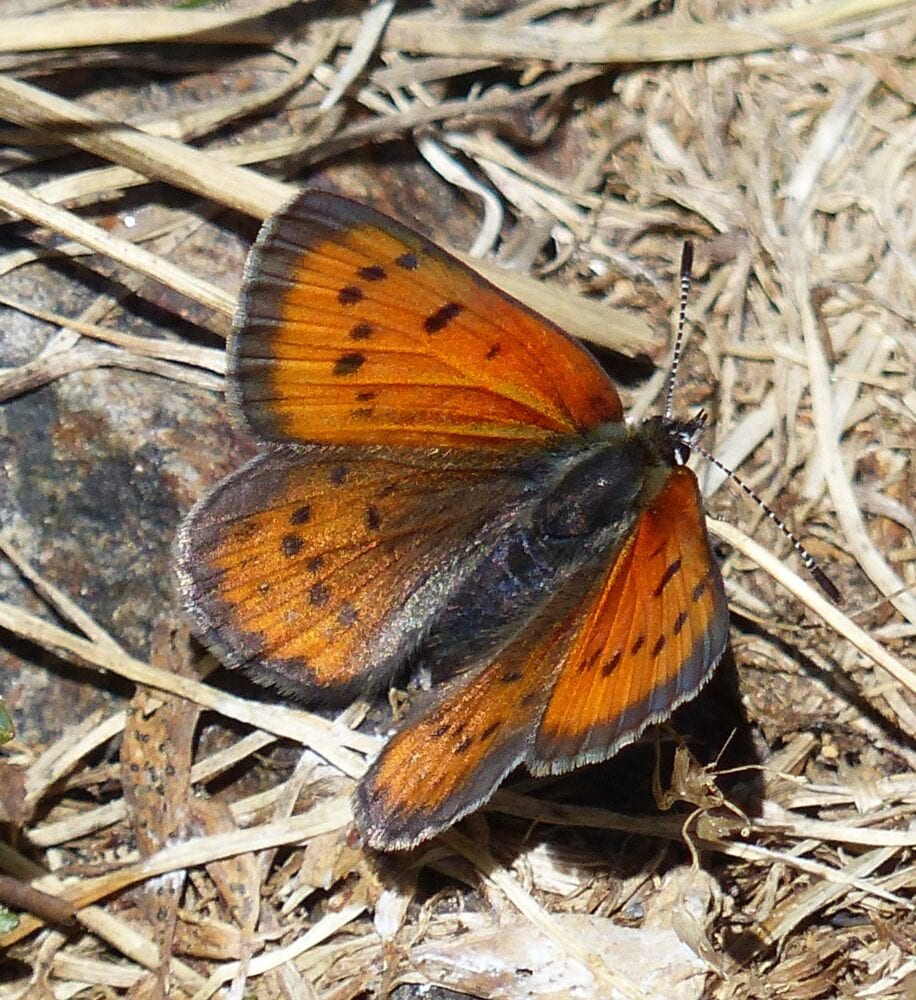
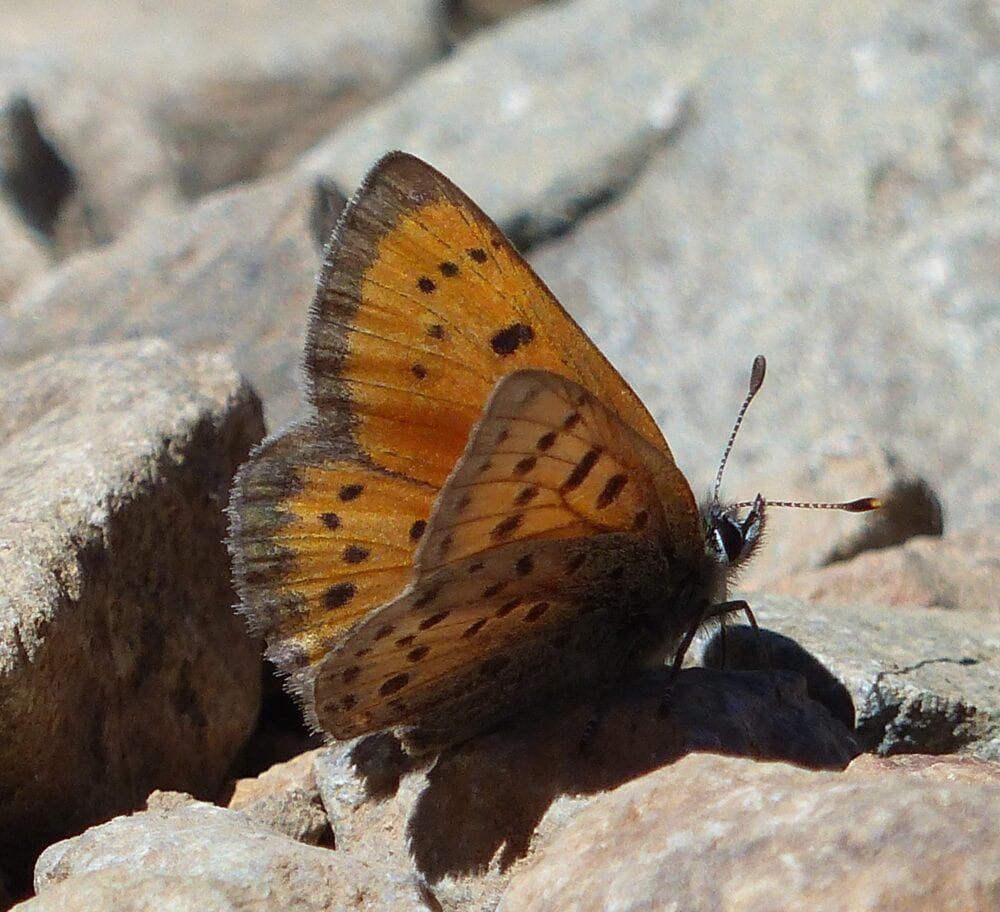
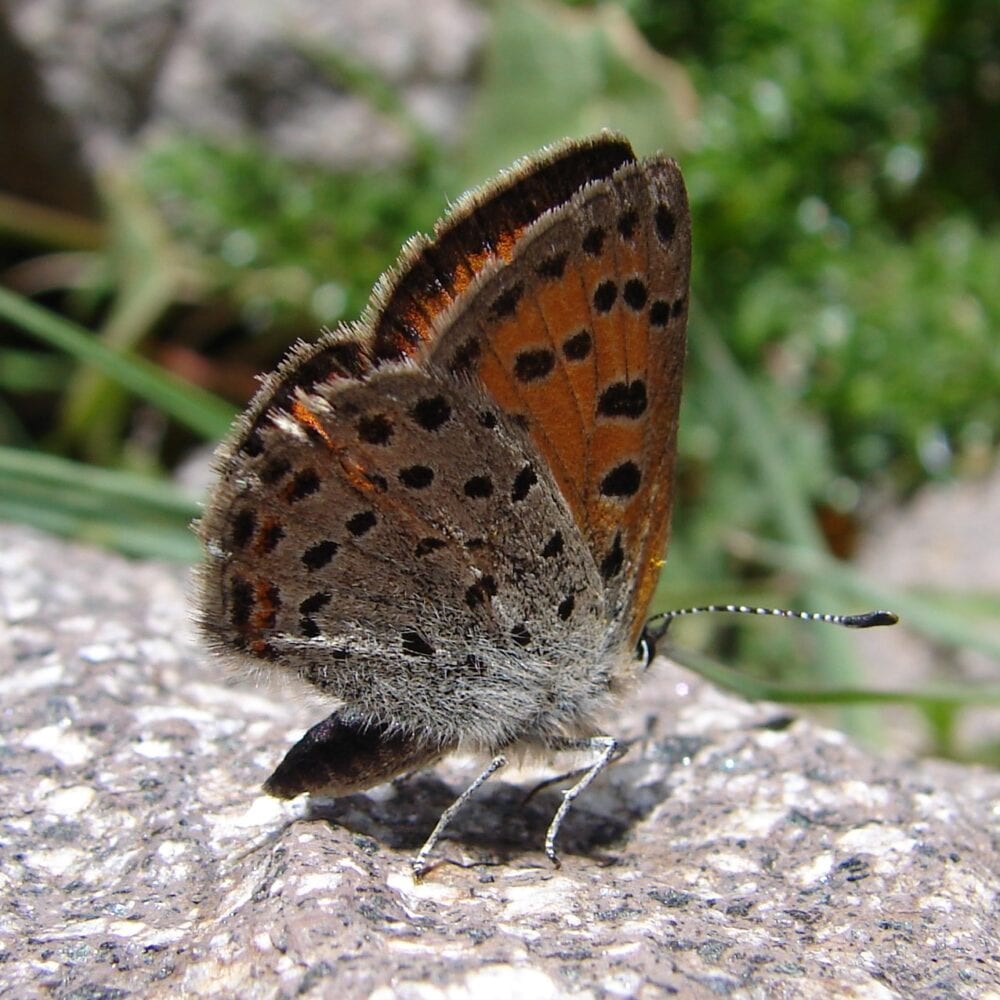
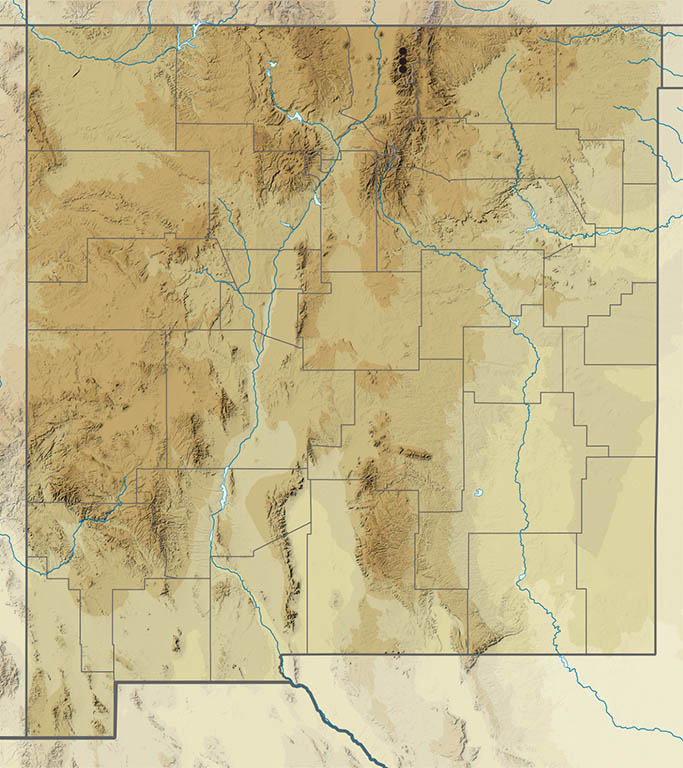
Tharsalea hyllus (Cramer 1775) Bronze Copper (updated March 14, 2022)
Description. Larger even than the so-called Great Copper, Bronze Copper is bright orange-brown above with black dots and an orange hindwing submarginal band. Underneath, the hindwing is gray-white with black dots and the same orange submarginal band. Orange invades deeply into the ventral forewing. The wingspan ranges from 3.2 cm to almost 5 cm. Range and Habitat. Bronze Coppers are regular marsh and swamp dwellers in the northeast US. Peripheral western colonies dot the prairies east of the Rockies north into Canada and south into northeast New Mexico (counties: Co,SM,Un). Life History. Larvae eat dock (Rumex spp.; Polygonaceae). Western populations are linked to curly dock (Rumex crispus) in disturbed, wet areas. Eggs must be submerged before they will hatch. Flight. In the eastern US the Bronze Copper is largely double-brooded, while western populations vary from univoltine to bivoltine. New Mexico adults fly from June 19 to August 26, probably in two broods. They dart through weedy, wet meadows, perch in tall grasses and go to nectar. Comments. Jane Ruffin discovered our first New Mexico colony in at Maxwell National Wildlife Refuge (Co) in 1996. This species colonizes reservoir edges and seems to profit from human changes in western landscapes (Ferris and Brown 1980).
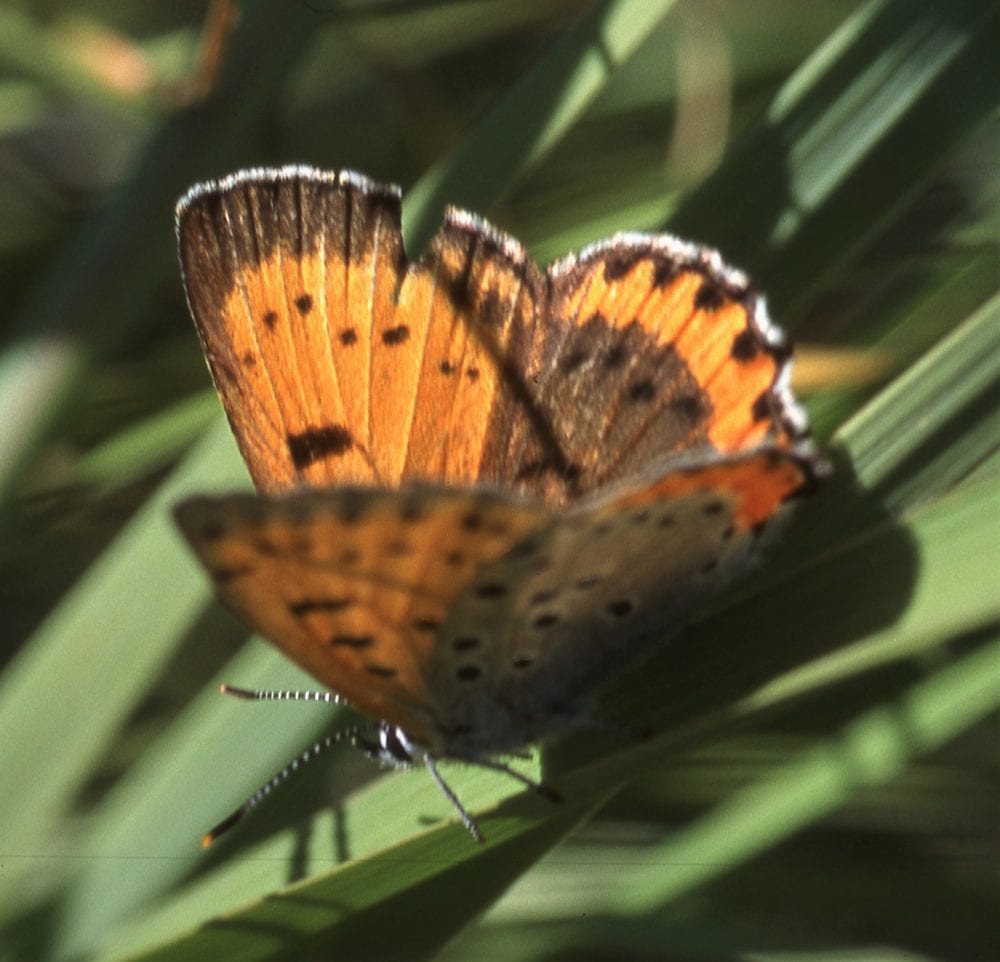
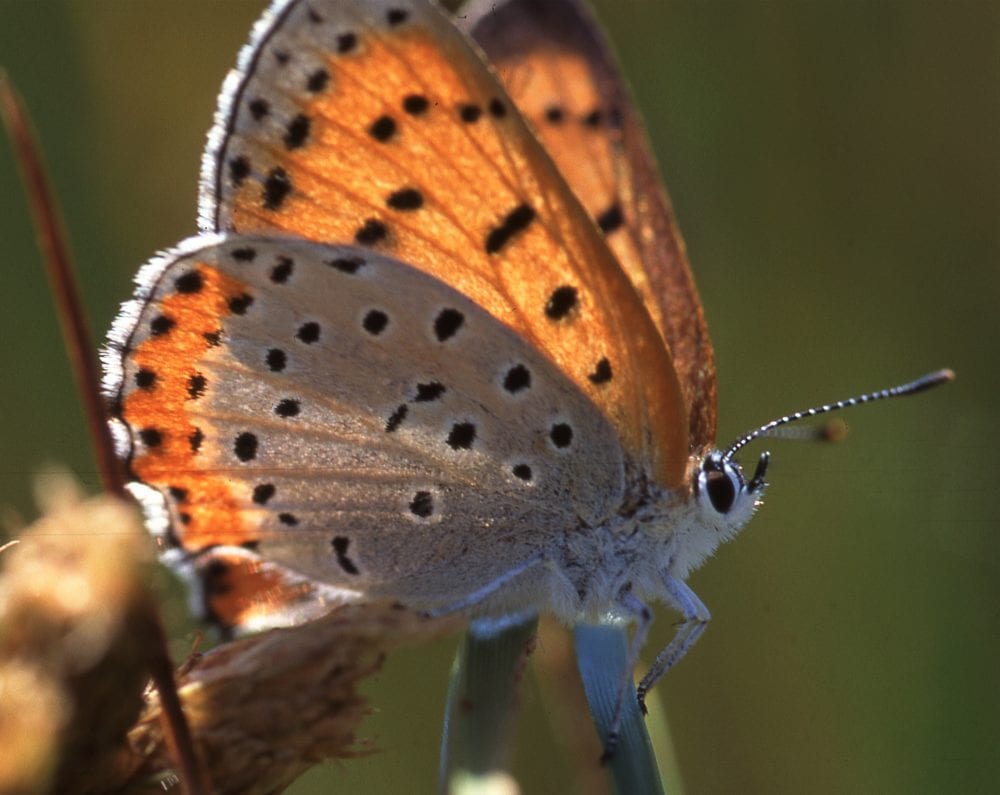
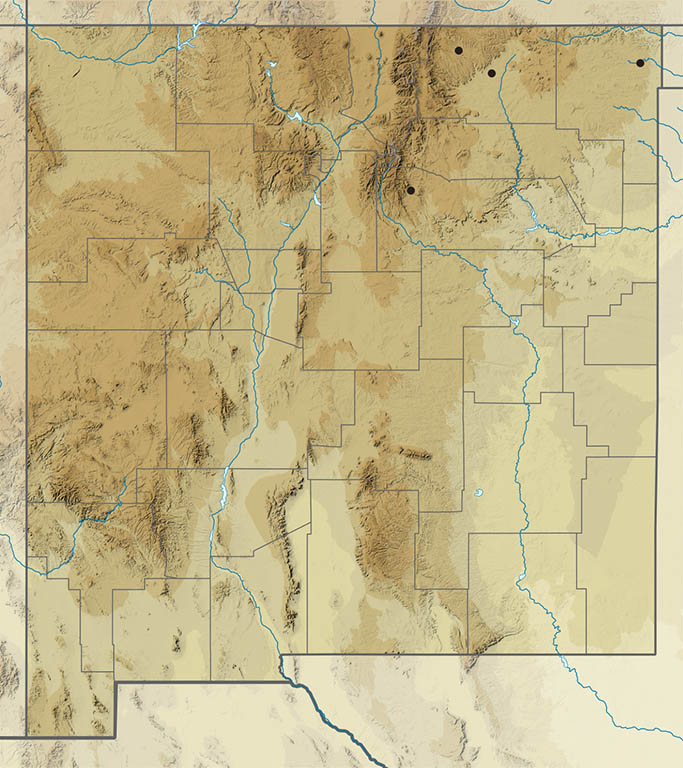
Tharsalea heteronea Boisduval 1852 Blue Copper (updated March 14, 2022)
Description. Tharsalea heteronea is much like Tharsalea rubidus, but for the dorsal color. Males are bright sky blue; females lack a hindwing orange band. Range and Habitat. Blue Coppers share most of their greater distribution range with Ruddy Coppers: Rocky Mountains, Great Basin and the Sierra Nevada. It is a Transition and Canadian Zone insect in New Mexico, where it lives in our north-central mountains (counties: Co,RA,Sv,Ta), 7200 to 9100′ elevation. Life History. Blue Copper larvae eat various species of wild buckwheat (Eriogonum spp.: Polygonaceae). Jane Ruffin observed oviposition on Eriogonum racemosum 10 miles west of Chama (RA) on 28 July 1999. The egg stage passes the winter. Flight. Blue Coppers go through one generation per year; adults emerge in mid-summer and are on the wing between July 5 and August 23. Larger than any of our true blues (Lycaenidae: Polyommatinae), Blue Coppers patrol and nectar in flowery mountain meadows amid dense stands of the host. Comments. Our populations belong to subspecies Tharsalea heteronea gravenotata Klots 1930. Scott (1986) commented on convergent evolution of Blue Coppers and blues in the genus Euphilotes. Both have blue males, brown females and use wild buckwheats (Eriogonum spp.) to feed larvae.
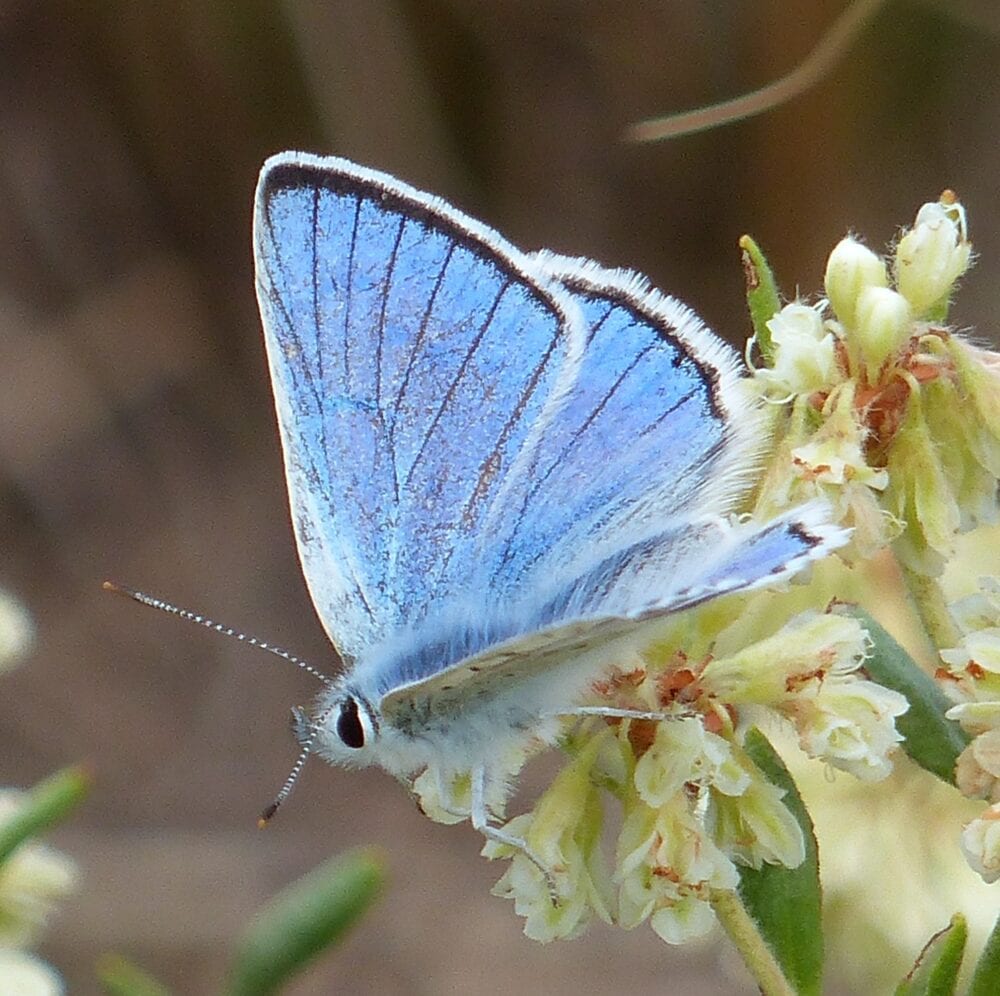
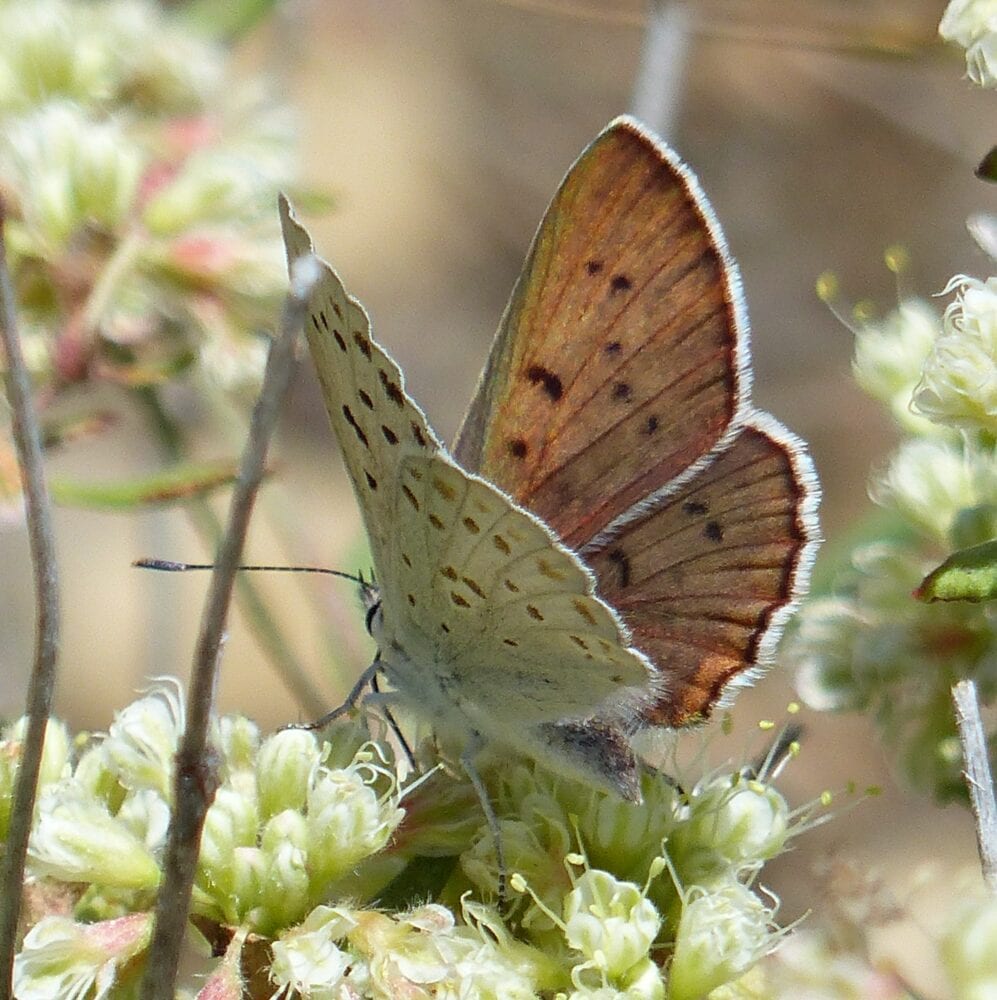
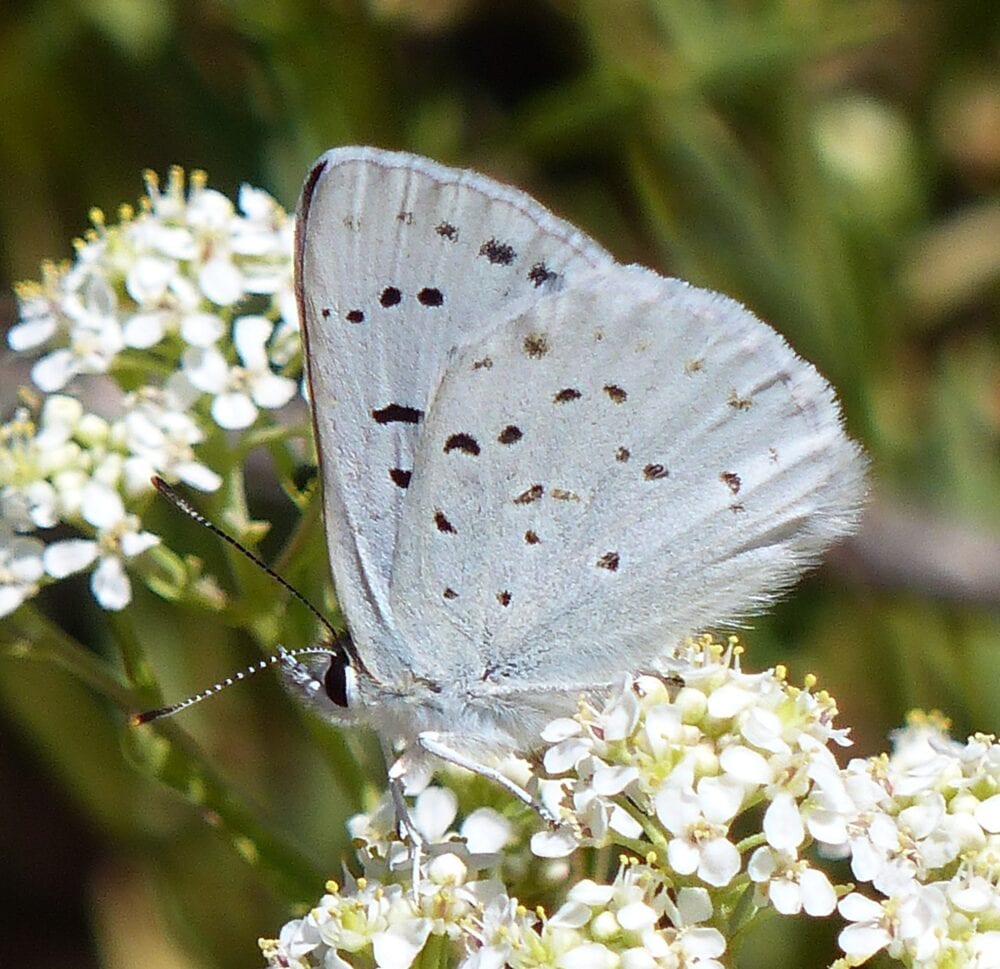
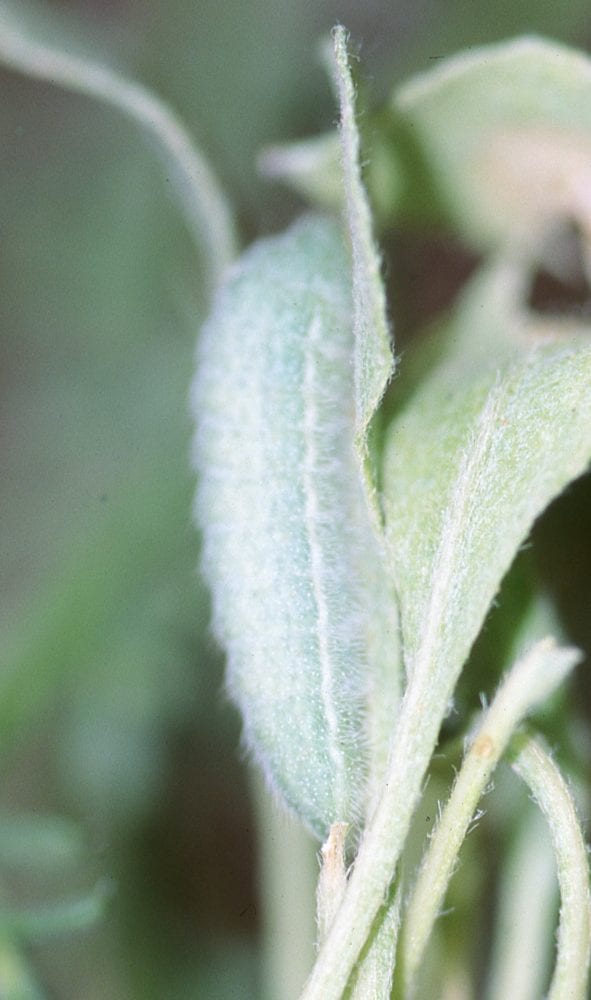
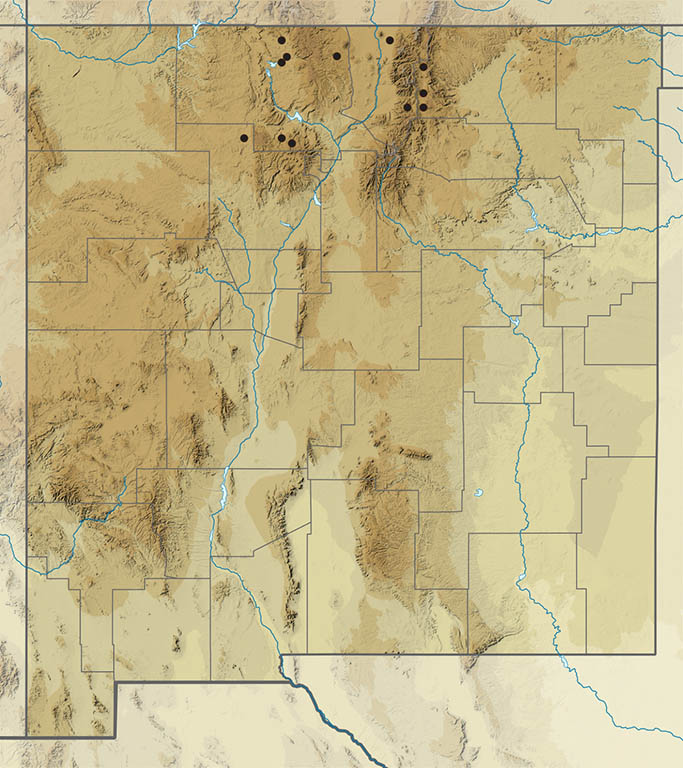
The “Purplish” Copper Complex (added January 2024)
In 2009, Mike Fisher said that relationships between ‘purplish’ copper “populations in Colorado [and northern New Mexico] have long been in doubt, a matter of opinion or subject to disagreement.” Fourteen years later, Pelham (2023) stated: “There is no consensus on relationships between taxa in the Tharsalea dorcas complex (e.g. Ferris (1977), Bull. Allyn Mus. (45): 1-42, Scott (1979), J. Res. Lepid. 17(1): 40-50, (2006), Papilio (n.s.) 12: 44-45, and (2008), Papilio (n.s.) 18: 43-55. It seems clear that “florus” is not conspecific with dorcas but not at all clear that helloides and florus are different species despite reports of sympatry. This lack of definition makes identifications suspect.” The experts leave us no choice but to treat the next two or three (who knows how many?) copper species as a complex, at least in the Rocky Mountains. If the complex resembles a tangled ball of string, there are a couple of dangling ends and our discussion below uses those as starting points. Nevertheless, our taxonomic arrangement below carries no weight whatsoever; we will make adjustments as soon as more clarity is available.
Tharsalea helloides (Boisduval 1852) Purplish Copper (updated January 24, 2024)
Description. Male Tharsalea helloides are iridescent purple-brown above; the purple glint fades with age; dorsal hindwing margin has prominent row of three or more plump orange crescents. Females are flat orange above, occasionally brownish near the body; DHW marginal orange crescents are prominent. Both sexes have dark spots in same pattern as Dorcas. Hindwing undersides are tan/lavender with small dark spots and a crenulate orange marginal band; the ground color can vary seasonally. Adults are smaller than most other coppers. Range and Habitat. Purplish Copper is versatile and widespread. It occurs from Alaska to Baja California and east to the Great Lakes, in life zones from Upper Sonoran to Hudsonian. Here it occurs in streamside or other wet habitats, 5000 – 11,000′ (counties: Co,LA,Mo,RA,Sv,SJ,SM,SF,Ta). Life History. Several Polygonaceae are hosts, including various Rumex spp. and Polygonum spp. New Mexico hosts have not yet been specifically identified. Flight. Purplish Coppers are bivoltine, perhaps even trivoltine, at lower sites, flying May 15 to September 10. Above 8000′, confusion starts to set in regarding species identities, but whatever it is flying up there seems to be univoltine, with extreme dates of June 8 to September 7, as might be expected in a short growing season. Adults fly about hosts seeking nectar and water. Comment 1. Experts disagree whether all southern Rocky Mountain populations truly are Tharsalea helloides or a separate species, Tharsalea dorcas W. Kirby (1837) (e.g., Ferris and Brown 1980). The two are nearly identical in appearance; differences in voltinism and larval hosts may or may not be taxonomically significant. Pelham (2023) acknowledged the lack of consensus on relationships among members of this “complex” and called for more study.

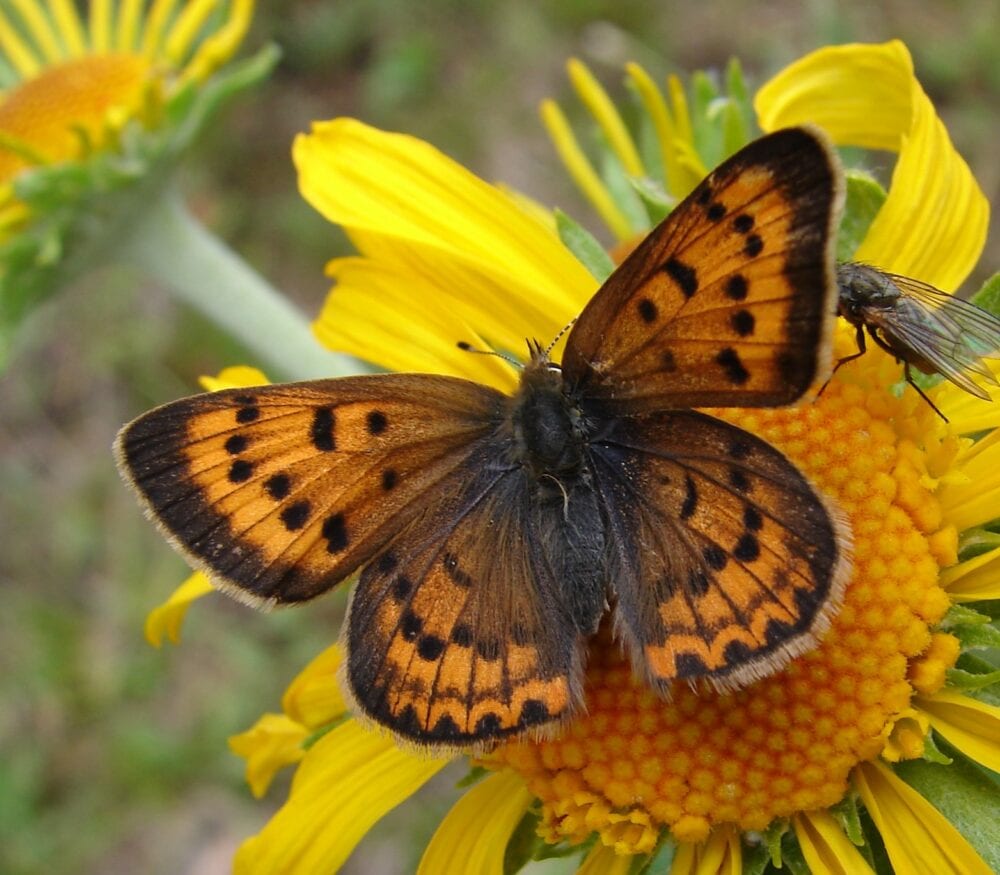
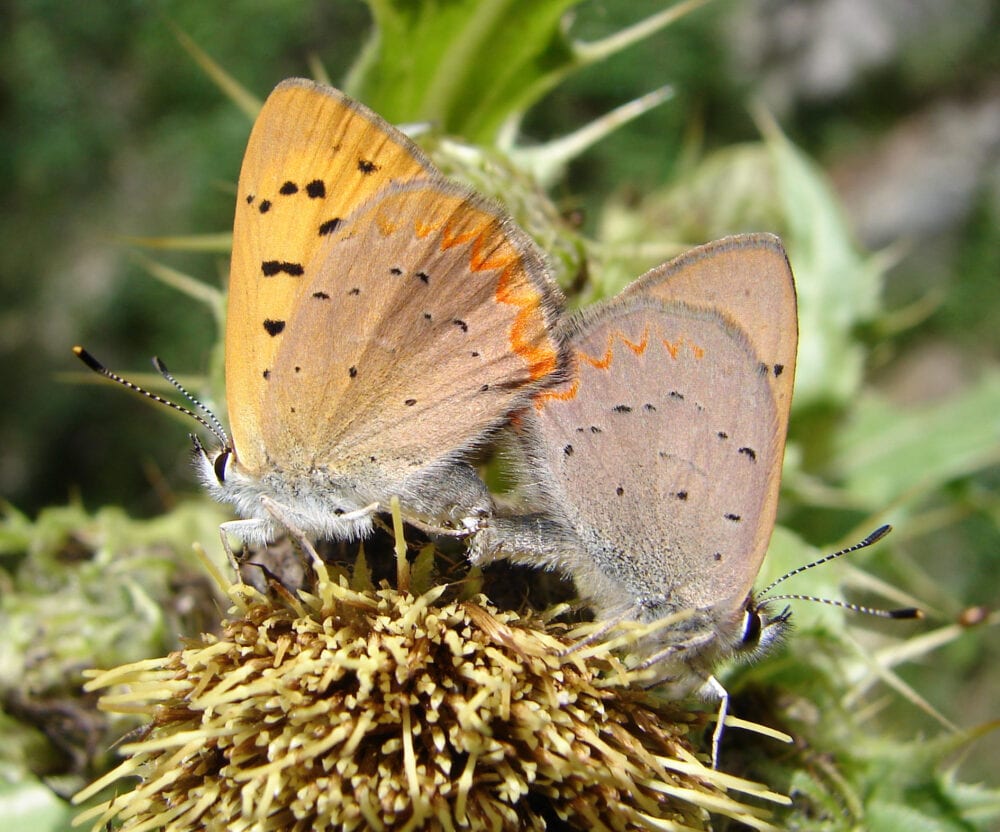
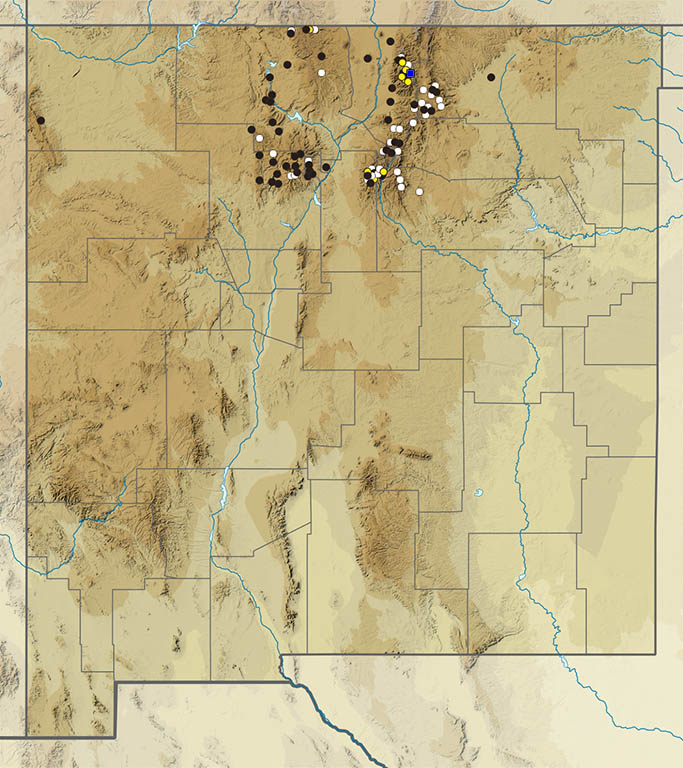
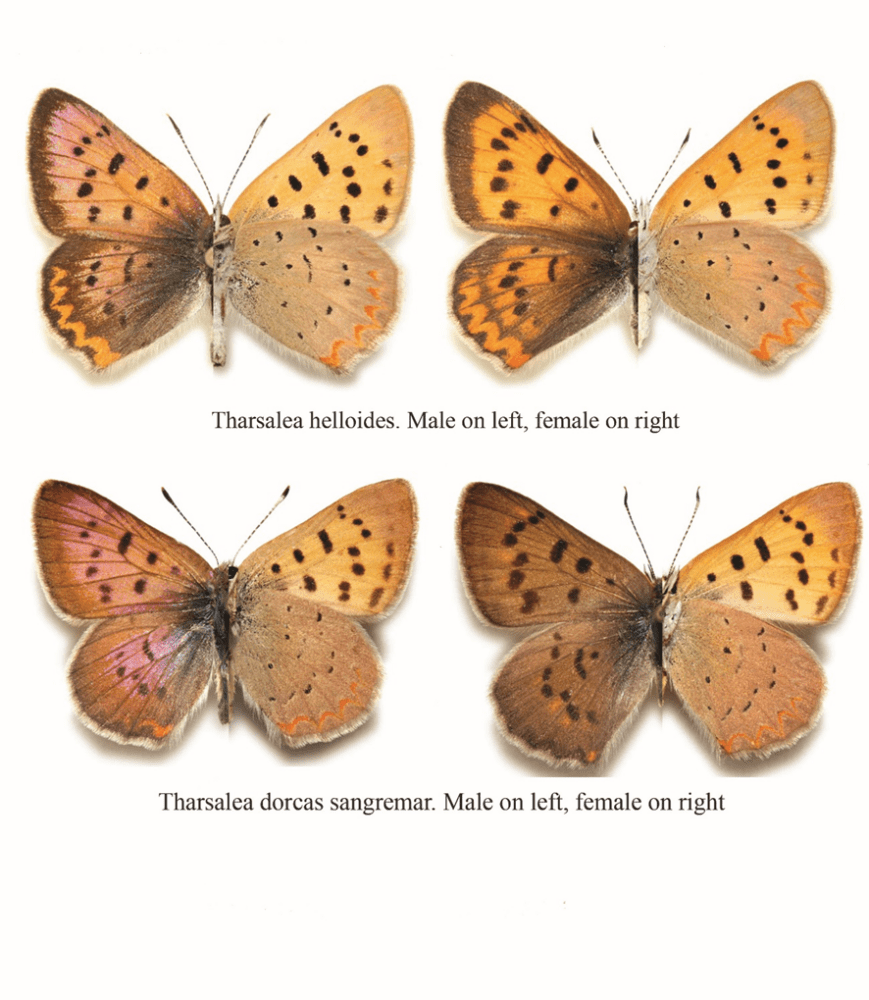
Tharsalea dorcas (W. Kirby, 1837) Dorcas Copper (updated February 8, 2024)
Description. Male Dorcas are bronze above with a purple iridescence at the right light angle; the purple sheen can be more prominent than on Purplish Copper. Female dorsal ground color is more muted brown than bright orange; both sexes are decorated with a pattern of dark spots that is heavier on females. Orange lunules on the dorsal hindwing tend to be few in number, one to two, but the variation in number overlaps that of T. helloides. Hindwing undersides are light tannish lavender with small dark spots and a crenulate orange marginal band. Like Purplish, adult Dorcas are smaller than most other coppers. Range and Habitat. Dorcas Copper is a high mountain butterfly that lives in the Sangre de Cristo Mountains of northern NM northward into the Yukon. It is more restricted to high elevations than Purplish, preferring the Hudsonian life zone, 10,000 – 11,000 feet, occasionally down to 9,000 (projected counties: Co,Mo,RA,SM,SF,Ta). Life History. Scott (2008) documented that larval hosts include blueberries (Vaccinium spp.; Ericaceae). New Mexico hosts have not yet been specifically identified. Flight. Dorcas Coppers are univoltine, flying June 8 to September 7 above 8000′. Adults bask dorsally, then seek nectar and water. Comment 1. The late Dr. James A. Scott (2008) described sangremar as a distinct subspecies based on specimens collected “NE of Taos Ski Valley, 10400′, Sangre de Cristo Mts., Taos Co. New Mex.” Comment 2. In trying to distinguish helloides from dorcas, some past workers focused on wing characters which we highlight in the attached photos: (a) development of orange marginal crescents on DHW (more = helloides, fewer = dorcas); on females, the extent of brown vs. orange dorsal ground color (more brown = dorcas, more orange = helloides. But examination of a couple dozen individuals from anywhere in NM reveals that these characters span a range from one extreme to the other, with most specimens in the middle. We illustrate the extremes here and while they may be suggestive, they are probably not definitive. Comment 3. The two are nearly identical in appearance; differences in voltinism and larval hosts may or may not be taxonomically significant.
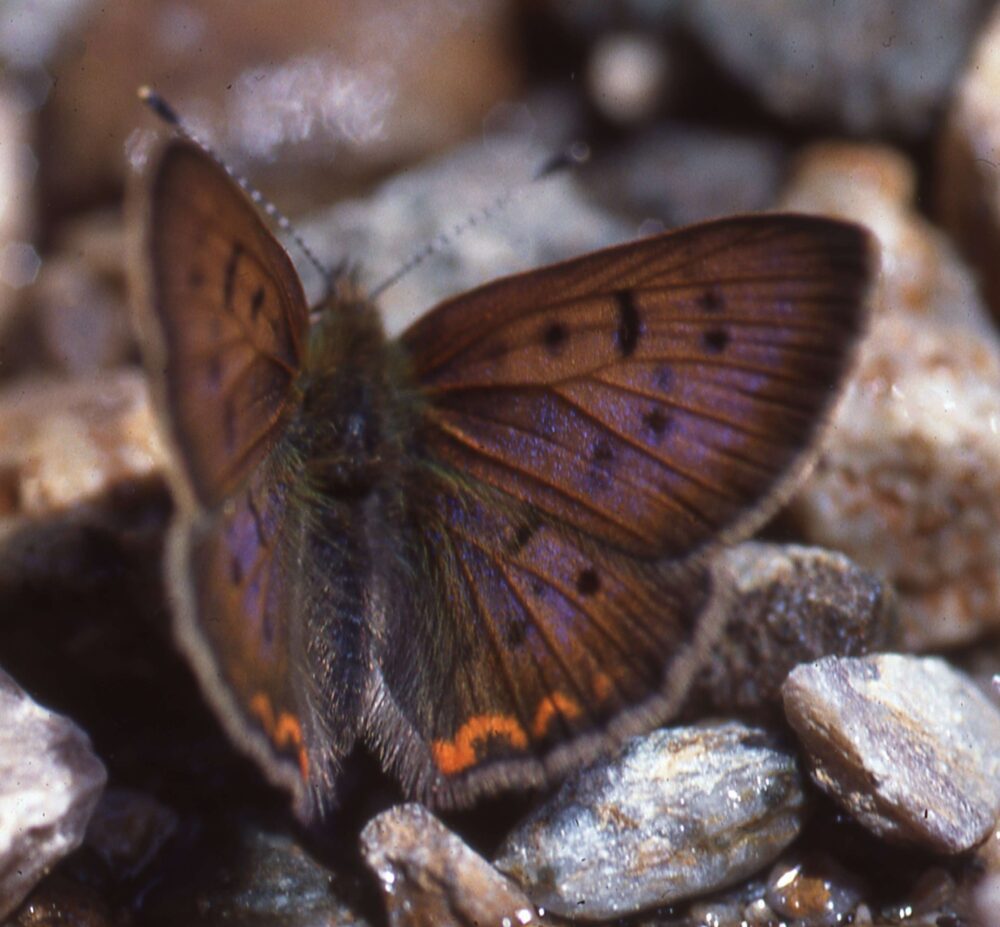
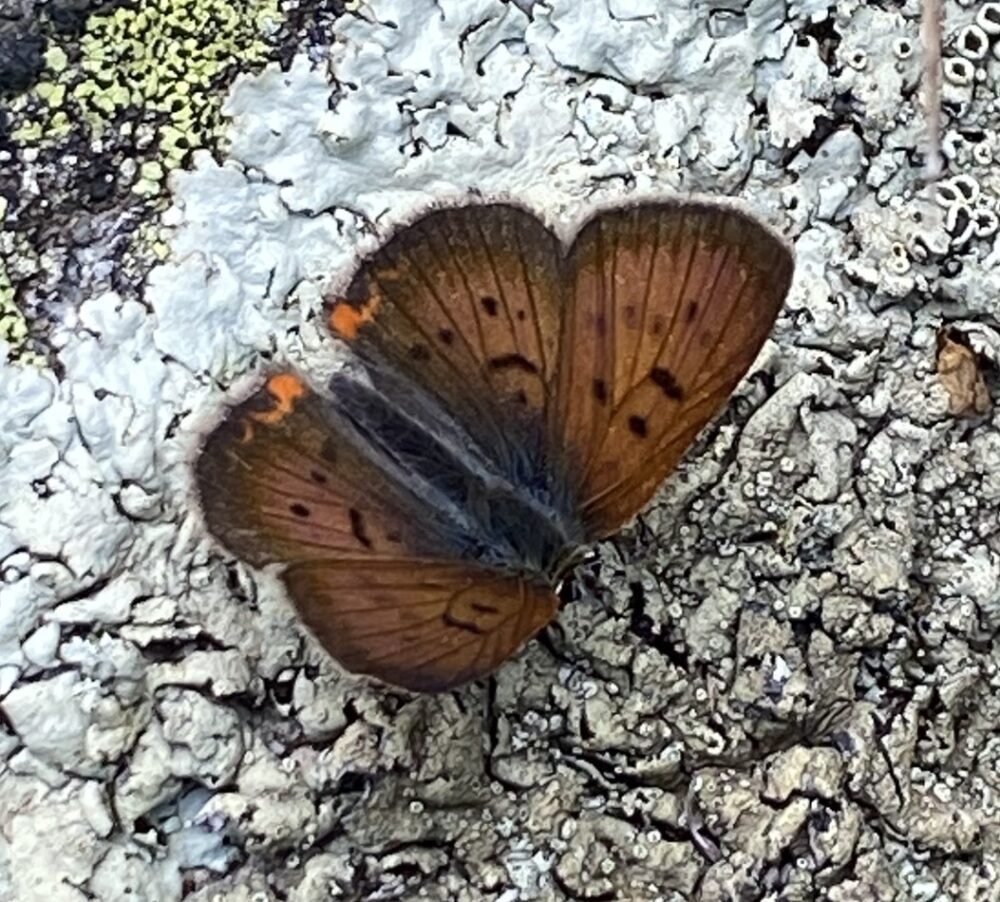
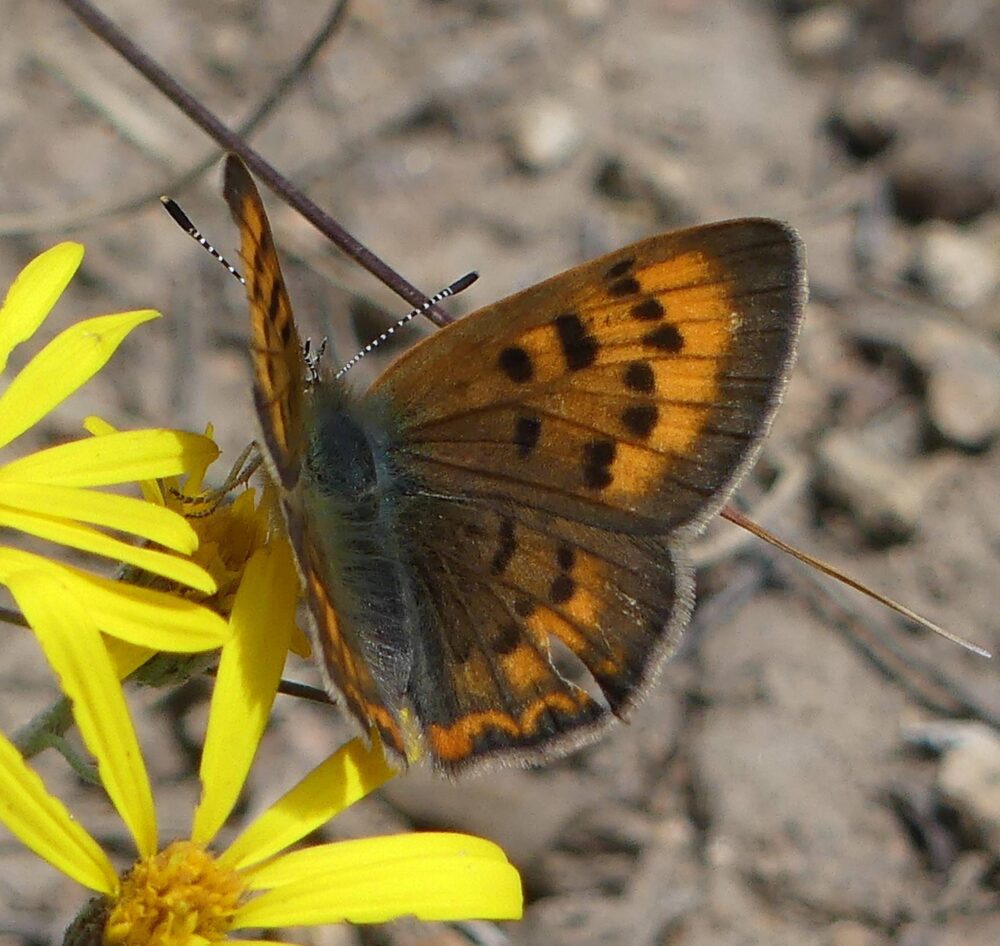
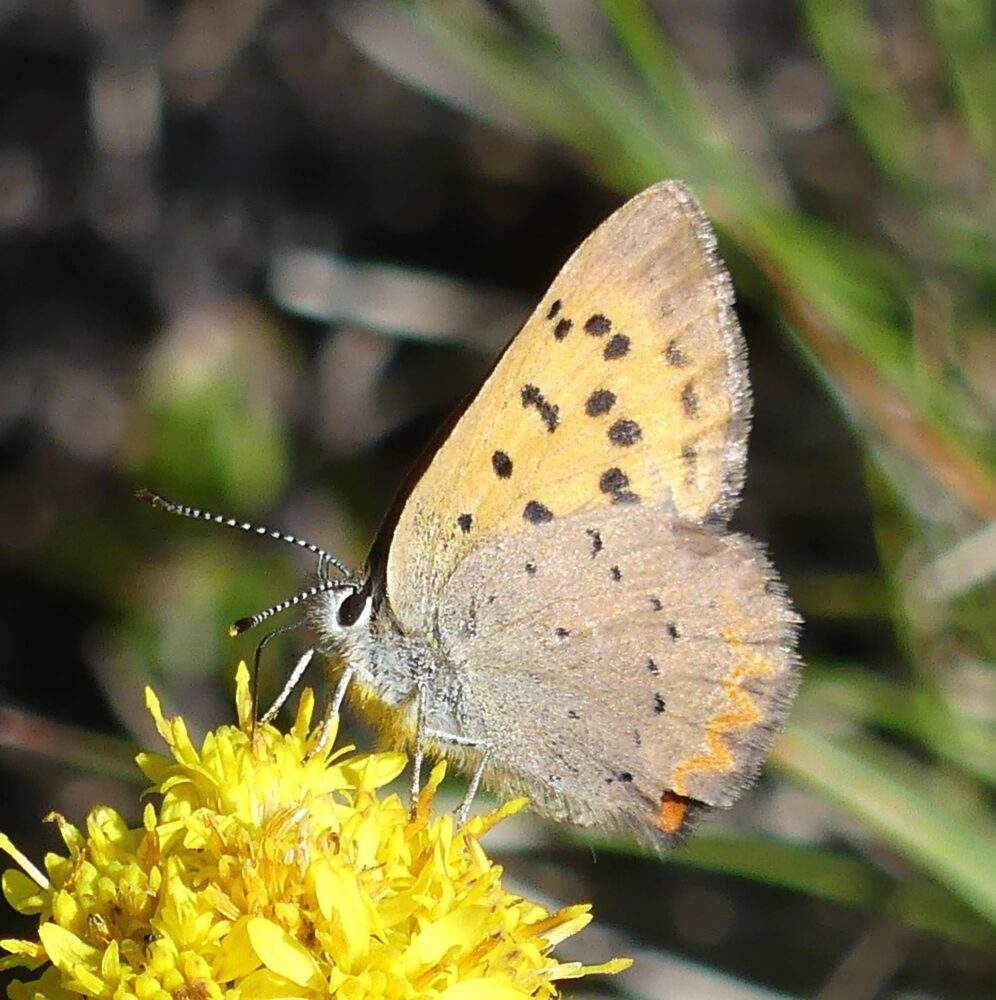
Tharsalea rubidus (Behr 1866) Ruddy Copper (updated March 4, 2025)
Description. This may be the flashiest of all New Mexico coppers. Dorsally, male Ruddies are iridescent dayglo vermilion with a vague suggestion of dark spots. Females are brown and spotted above, with an orange hindwing border. Undersides are gray to white with bold forewing dark spots and reduced hindwing dark spots. Range and Habitat. Tharsalea rubidus likes Transition or Hudsonian Zone habitats from the Sierra Nevada east to the High Plains and north to Alberta, preferring sage plains, prairies and savannas. There are a few colonies in our north-central mountains (counties: Co,Ra,Ta), usually 7500 to 9400′ elevation. Life History. In the Rockies, larvae eat Polygonaceae such as Oxyria digyna, Polygonum douglasii, or various Rumex spp. It uses Eriogonum jamesii v. jamesii south of Angel Fire (Co). Eggs overwinter. Flight. Our single mid-summer flight spans June 22 to August 26. Adults bask and nectar in alpine meadows having the larval hosts. Comment 1. Greg Forbes first observed Ruddy Copper in New Mexico at Romero Ranch, 7500′, San Antonio Creek (RA) on 11 July 1968. Populations in north-central New Mexico belong to Rocky Mountains subspecies Tharsalea rubidus sirius (W. H. Edwards 1871). Comment 2. Exploration of the Gila Wilderness in Catron County may uncover Ferris’ Ruddy Copper, Tharsalea rubidus ferrisi (K. Johnson & Balogh, 1977), a local endemic known only from east-central Arizona, which is hosted by Rumex occidentalis. The type locality for ferrisi is about 35 miles west of our border (Ditch Camp, east of McNary, Apache County, AZ), and there are a number of records within 10 miles of our border (yellow dots on our map). Could Ferris’ Copper be a distinct and full species?
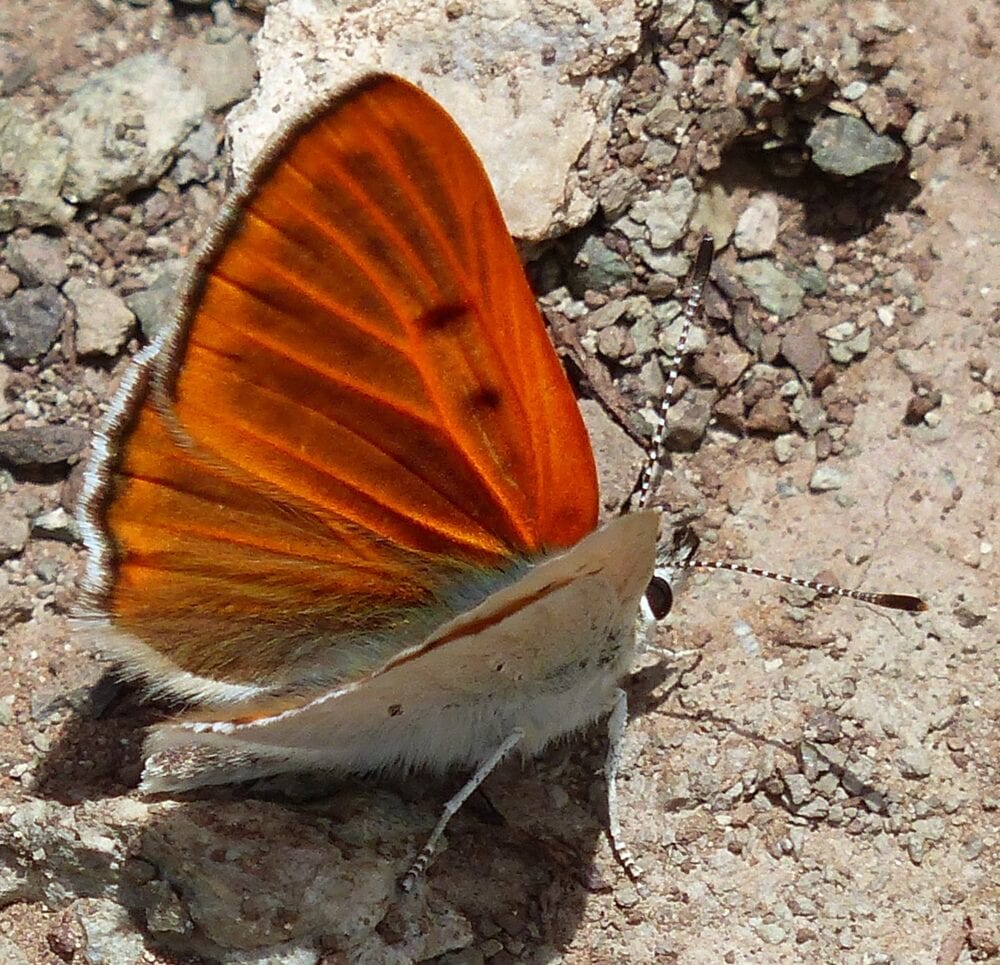
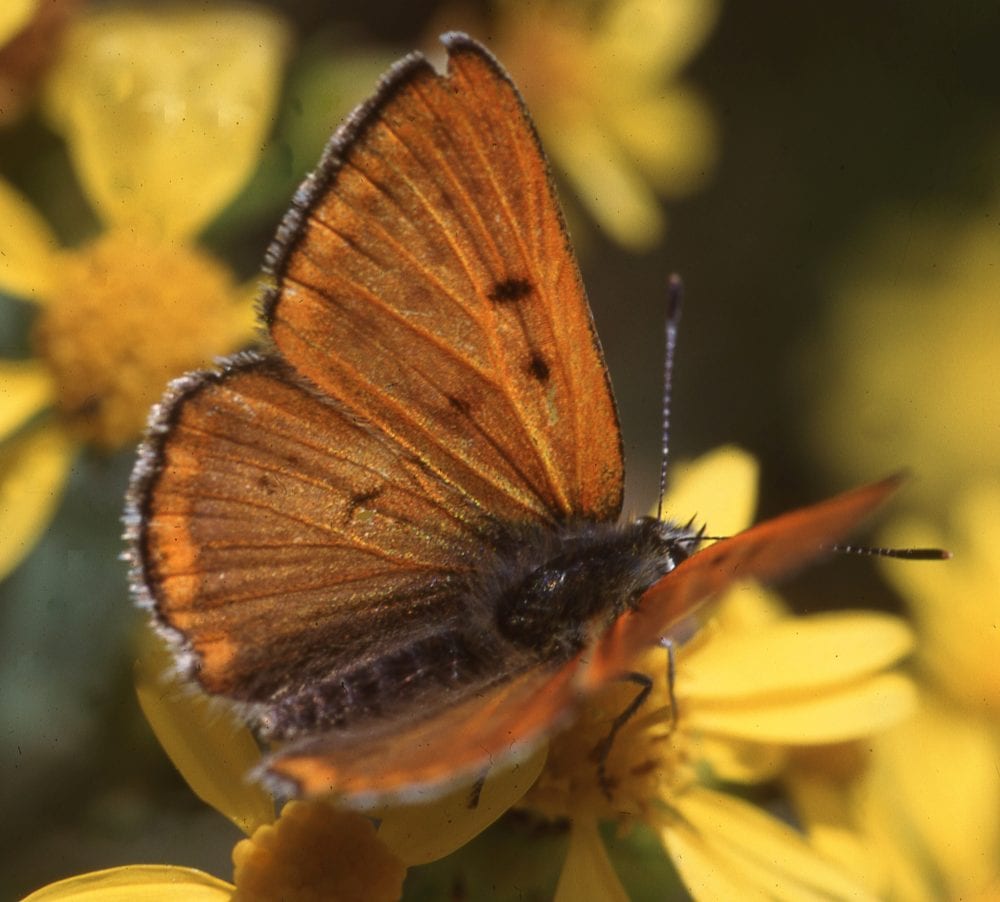
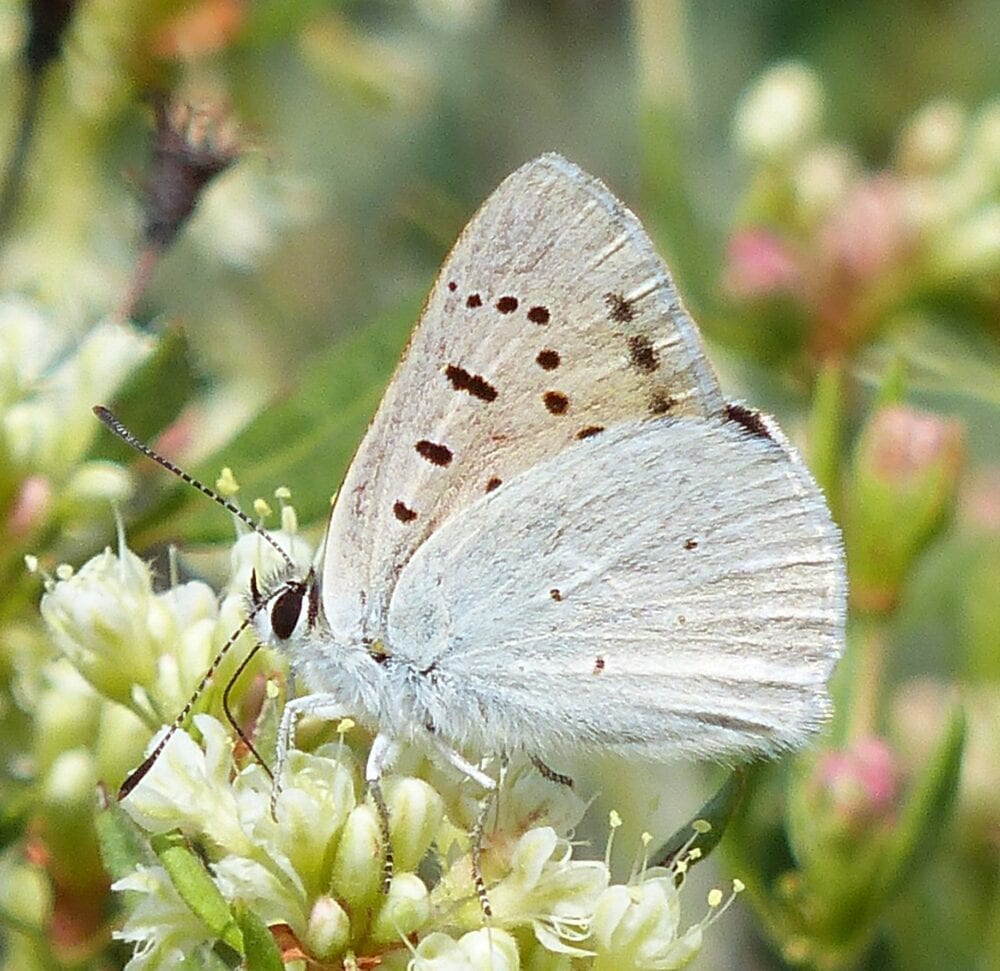
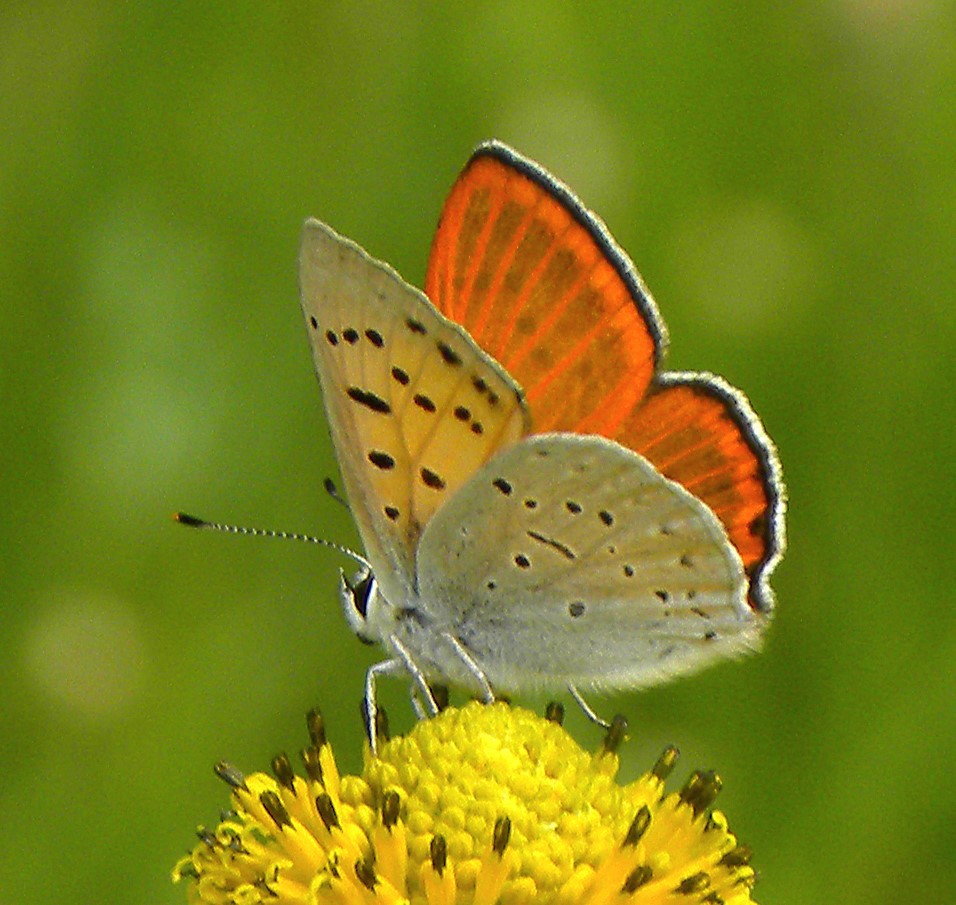
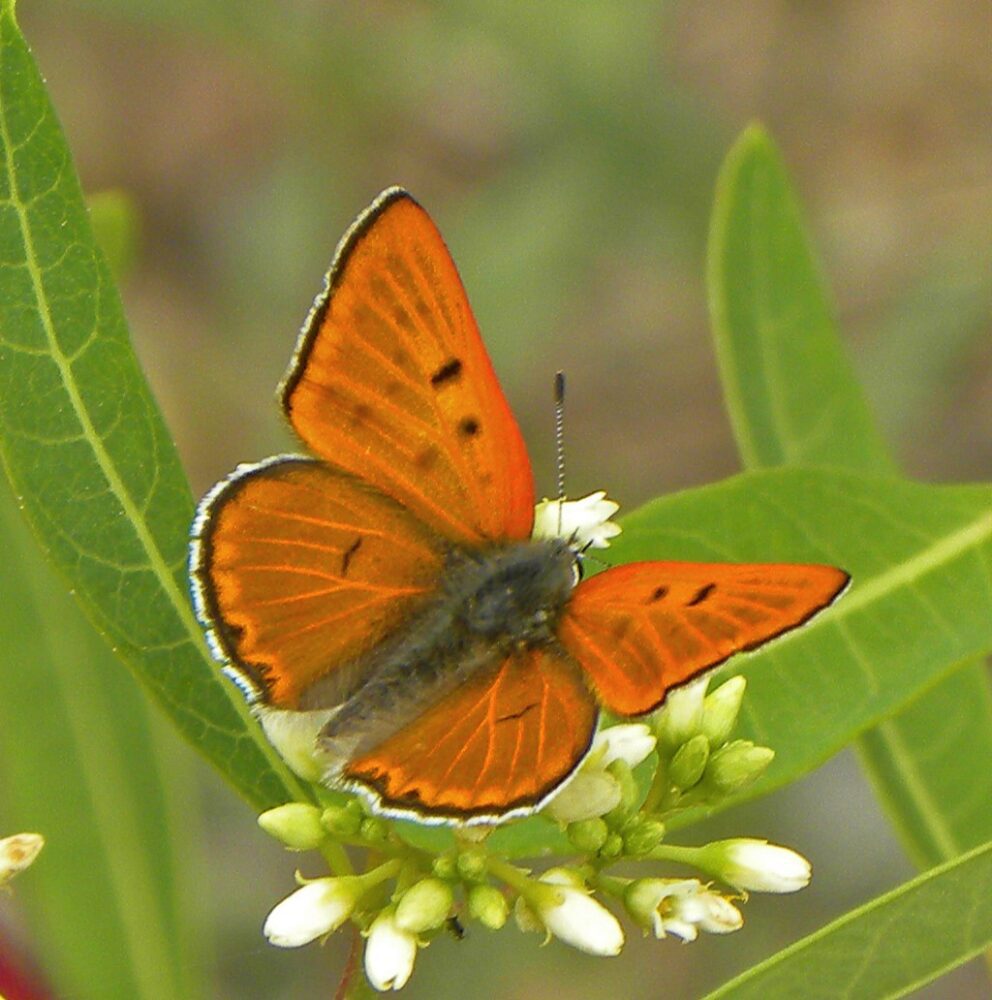

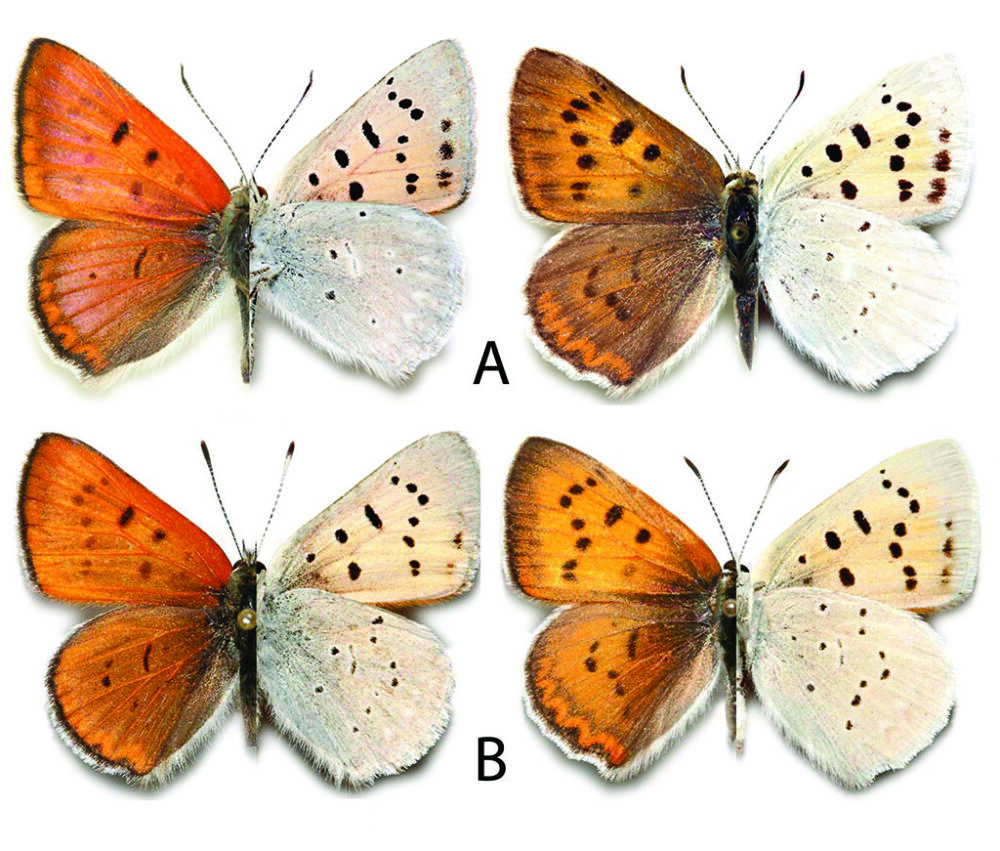
Tharsalea dione (Scudder 1868) Gray Copper (updated March 14, 2022)
Description. Gray Copper is slightly larger than most other coppers. It is gray-white below and dark gray above, with dark spots on all wing surfaces. Males tend to have fewer dark spots dorsally than other coppers, while females have the usual “copper spots”, although those are somewhat muted compared to other female coppers. Females also have a prominent marginal orange band with black spots. Black-pupiled orange spots decorate forewing and hindwing submargins. Range and Habitat. Gray Copper occurs throughout the northern Great Plains, extending south as far as Northeast New Mexico (counties: Un). Its limited occurrence here suggests a preference for Upper Sonoran Zone reservoir margins and wet meadows, about 5200′ elevation. Life History. Larvae eat various species of dock, such as Rumex crispus and R. triangulivalvis (Polygonaceae). Specific hosts in New Mexico have not been ascertained. Eggs overwinter. Flight. Gray Copper is univoltine, with adults about in summer. Our two reports are from July 5 and 6. As noted by Ferris and Brown (1980), adults prefer to fly in late afternoon. They come to nectar and perch on or near the host. Comments. This butterfly was first found in New Mexico at Clayton Lake State Park in 1993. More searching in northeast New Mexico may show it to be more widespread.
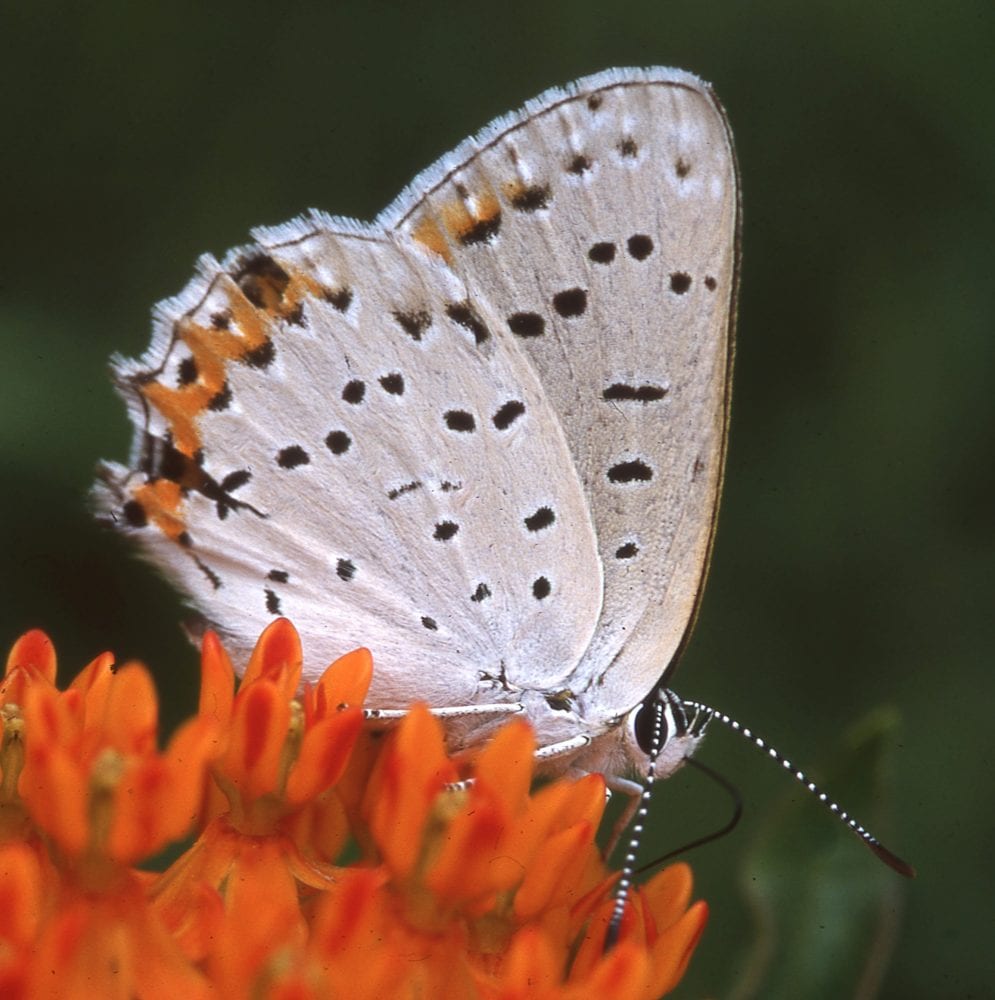
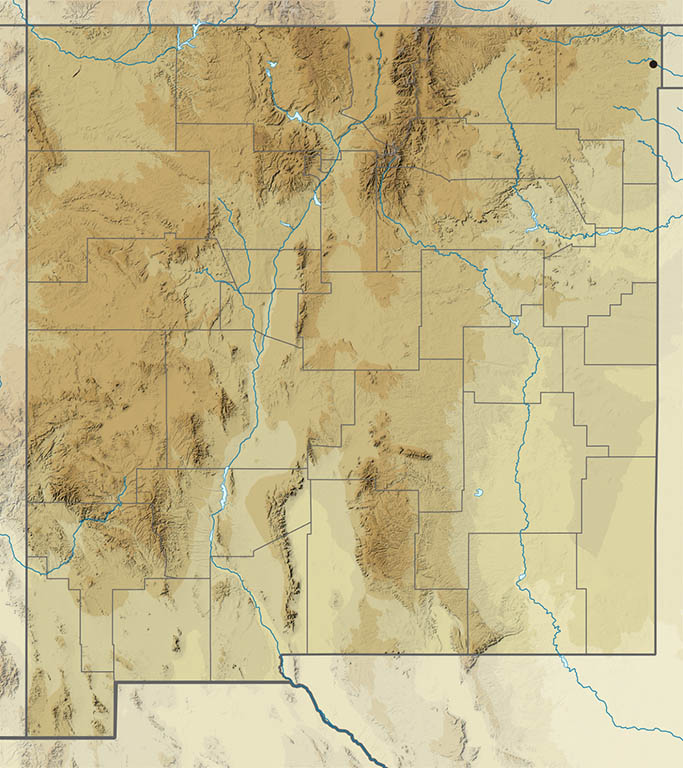
Tharsalea arota (Boisduval 1852) Tailed Copper (updated March 15, 2022)
Description. Tailed Copper is the only New Mexican copper with a hindwing tail, making it easy to identify. It has other hairstreak features as well, such as a “false head” at the hindwing tornus. Tharsalea arota males are iridescent purple-brown above with few dark marks, while females are orange above with more extensive dark marks. The ventral hindwing has a prominent submarginal white line, lacking in other NM coppers. Range and Habitat. Tailed Coppers inhabit open woodlands from coastal California east across the Great Basin to the Continental Divide in Colorado and New Mexico. Here, Tailed Coppers live in Transition Zone pine savannas in northern and western uplands (counties: Be,Ca,Ci,Co,LA,MK,Mo,RA,Sv,SM?,SF,Ta,To,Un,Va), usually from 6500 to 9500′ elevation. Life History. Larval hostplants are gooseberries (Grossulariaceae). Recorded hosts in the Rockies include Ribes roezlii, R. velutinum, R. leptanthum, R. cereum, R. californicum, R. aureum and R. inerme. Winter is passed in the egg stage. Larvae eat leaves and do not make nests. Flight. Tailed coppers are univoltine, flying in mid- to late summer. New Mexico records are confined to the interval between June 23 and September 24 with maximum numbers in July and August. Adults stay close to stands of the host, travelling short distances to nectar at late summer flowers such as asters (Asteraceae) and wild buckwheat (Eriogonum spp.). Comments. Our populations belong to the Grand Canyon race, Tharsalea arota schellbachi Tilden 1955.
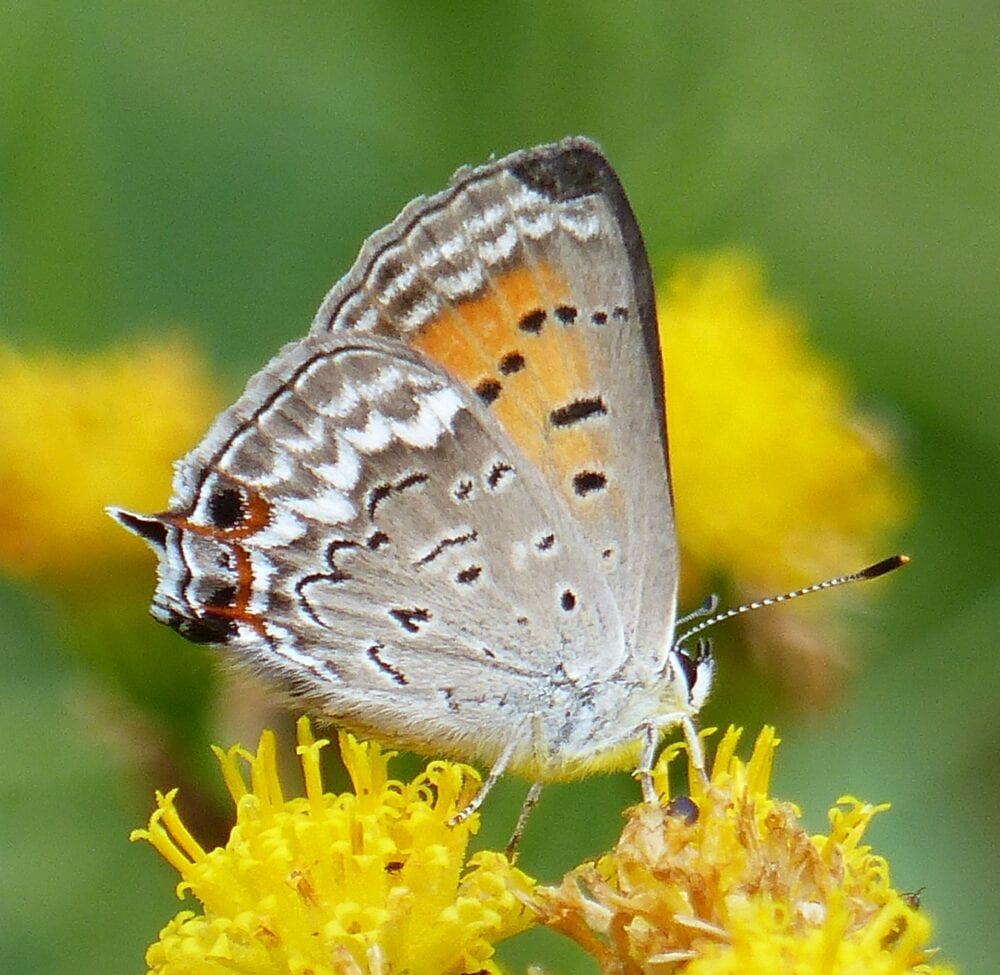

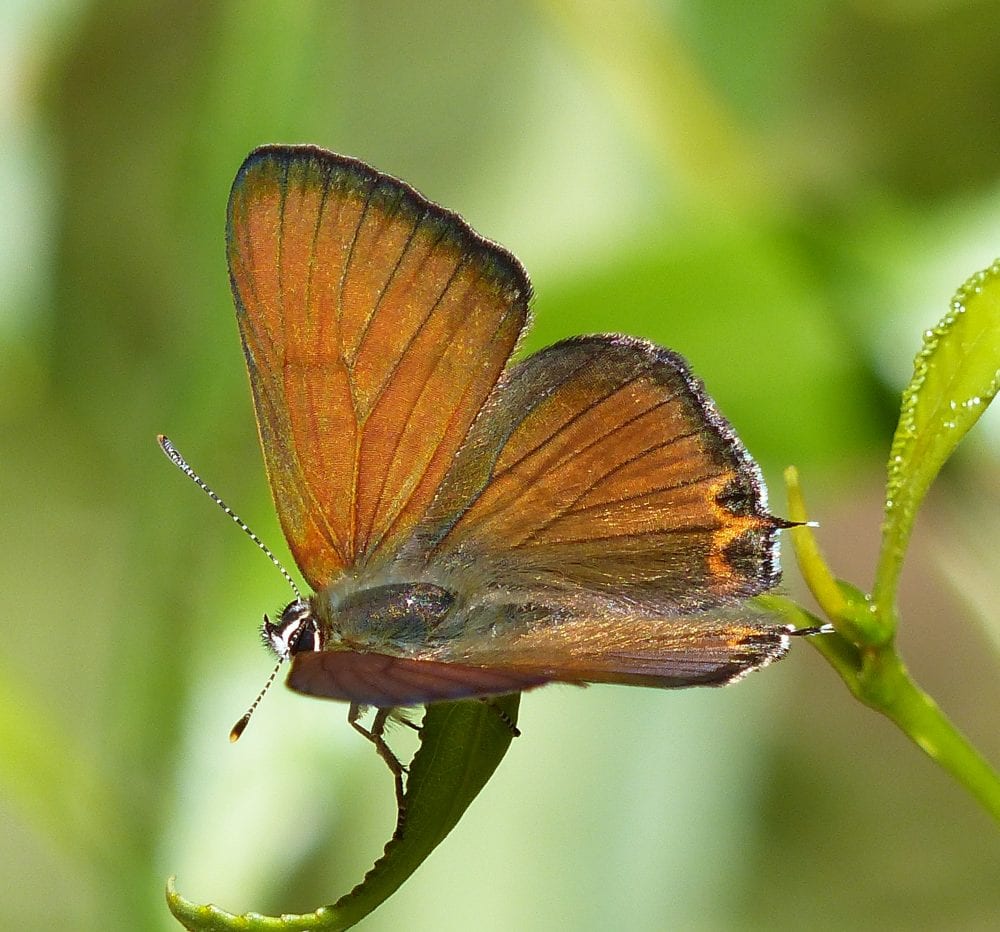
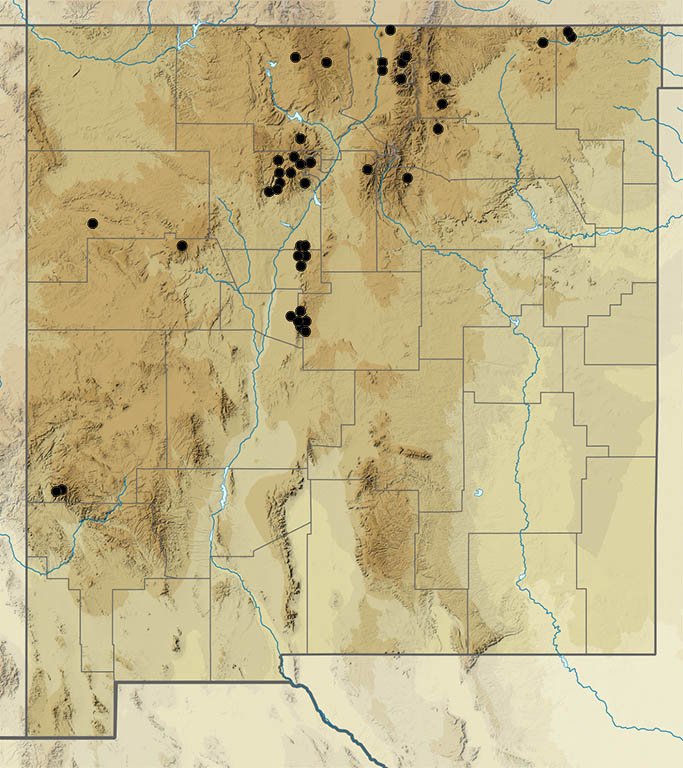
Tharsalea nivalis (Boisduval, 1869) Lilac-bordered Copper (added January 23, 2023)
Description. The upper surface of Lilac-bordered Coppers resembles helloides/dorcas (males) or heteronea (females). The typical spotting pattern of small coppers is present in this species. The distinguishing mark of this species is the remarkable two-toned appearance of the lower surface of the hind wings: the common name accurately describes that feature: a lilac border all along the outer margin. Range and Habitat. Lilac-bordered Coppers are found along the Pacific Coast from southern California north to southern Canada and then east to northern Colorado and Utah. Historical records indicate it occurs (or did occur) farther south to southern Colorado and Utah (and perhaps NW New Mexico). The species favors sagebrush flats above streams; areas many observers avoid. Life history. Larvae feed on Knotweed (Polygonum: Polygonaceae). Flight. In Colorado, the species flies from late June to August. Males perch on flowers to locate females. Comments. There are historical records from San Juan County, Utah, and La Plata and Montezuma Counties, Colorado – adjacent to NW New Mexico. No recent observations of Lilac-bordered Coppers have been made in these areas; most observations occurring far to the north. Perhaps Lilac-bordered Coppers are no longer present so far south, or perhaps the areas where they occur have not been searched. We include the species here “just in case.” Our subspecies, if found, would be Tharsalea nivalis browni (dos Passos, 1938).


